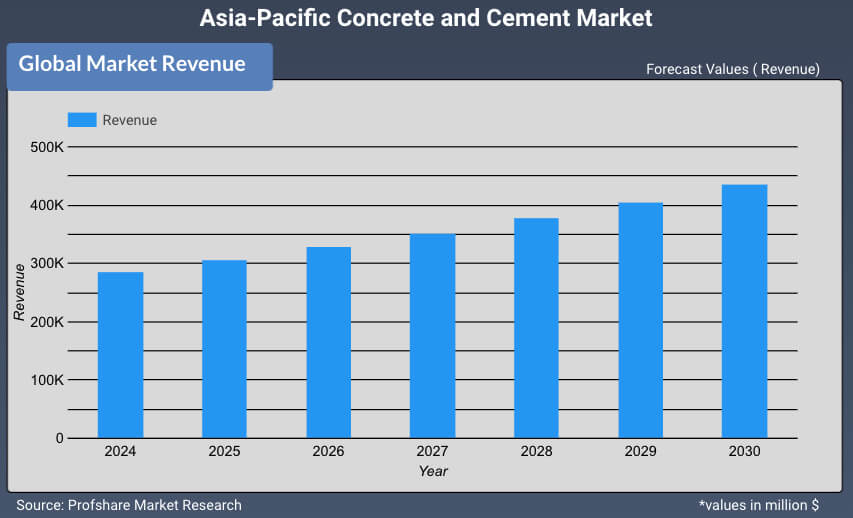Asia-Pacific Concrete and Cement Market Analysis & Forecast 2025-2031
Asia-Pacific Concrete and Cement Market Report By Product Type (Low Heat Cement, Sulphates resisting cement, Blast Furnace Slag Cement, High Alumina Cement, White Cement, Coloured cement, Pozzolanic Cement) By Application / End User (Residential Buildings, Industrial Buildings, Commercial Buildings) by Industry Analysis, Volume, Share, Growth, Challenges, Trends and Forecast 2025-2031, Regional Outlook ( North America, Europe, Asia-Pacific, Middle-East, Africa)
Global Asia-Pacific Concrete and Cement Market is expected to reach USD 435762.1 million by 2031 with CAGR of 7.3 % between 2025 and 2031
Cement is a fine mineral powder which is manufactured with very precise processes. A mixture of limestone and clay grinded together and then heated at a temperature of 1,450°C.This results into a granular substance called "clinker," a combination of calcium, silicate, alumina and iron oxide. The clinker is then cooled and stored, ready for grinding, to produce cement. Cement is the most important component of concrete. Cement is an economical, high-quality construction material used in construction projects worldwide.

Concrete is basically a mixture of paste and aggregates (sand & rock). The paste, mixture of cement and water, coats the surface of the fine (sand) and coarse aggregates (rocks) and binds them together into a rock-like mass known as concrete. By the process of hydration, the cement and water harden and bind the aggregates into a rocklike mass. This hardening process continues for years meaning that concrete gets stronger as it gets older.
Typically, by volume, concrete contains 10 to 15 % cement, 60 to 75 % aggregates and 15 to 20 % water. Entrained air bubbles in many concrete mixtures may also take up another 5 to 8 %. The key to a remarkable trait of concrete lies in this process: it’s plastic and can be molded or formed into any shape when newly mixed, strong and durable when hardened. These are the qualities which explains why one material, concrete, can build skyscrapers, bridges, sidewalks, and superhighways, houses and dams.
Profshare Market Research launches an in-detailed study of segments, market drivers, constraints, regional analysis, trends and forecast on Asia-Pacific Concrete and Cement Market. The market is expected to show constant growth between 2024 to 2030 2024 to 2030. The study covers a detailed analysis, growth and forecast of Asia-Pacific Concrete and Cement Market. The report includes market analysis on regional level. The study covers historical data analysis from 2018 to 2023 and market forecast for 2024 to 2030 based on revenue generated.
Asia-Pacific Concrete and Cement Market : Product Type
- Low Heat Cement
- Sulphates resisting cement
- Blast Furnace Slag Cement
- High Alumina Cement
- White Cement
- Coloured cement
- Pozzolanic Cement
Asia-Pacific Concrete and Cement Market : End Users/ Applications
- Residential Buildings
- Industrial Buildings
- Commercial Buildings
Global Asia-Pacific Concrete and Cement Market: Companies Covered
- Cemex
- Holcim
- HeidelbergCement
- Lafarge
- CRH
- Buzzi Unicem
- Italcementi
- Cimpor
- Votorantim
- US Concrete
- Shanghai Jiangong Engineering Material
- China Resources Cement Holdings Limited
- Southeast Cement Copporation
- West China Cement Limited
- Cahina Energy Enigeering Group
Geographical analysis of Asia-Pacific Concrete and Cement Market includes :
- China
- India
- Japan
- South Korea
- Indonesia
- Malasiya
- Singapore
Global Asia-Pacific Concrete and Cement Market Report delivers a comprehensive analysis of the following parameters:
- Market Forecast for 2025-2031
- Market growth drivers
- Challenges and Opportunities
- Emerging and Current market trends
- Market player Capacity, Production, Revenue (Value)
- Supply (Production), Consumption, Export, Import analysis
- End user/application Analysis
Report Coverage
| Parameters | Details |
|---|---|
Base Year |
2025 |
Historical Data |
2019-2024 |
Forecast Data |
2025-2031 |
Base Year Value (2024) |
USD 266104 million |
Forecast Value (2031) |
USD 435762.1 million |
CAGR (2025-2031) |
7.3 % |
Regional Scope |
North America, Europe, Asian Pacific, Latin America, Middle East and Africa, and ROW |
Frequently Asked Questions (FAQ)
Asia-Pacific Concrete and Cement Market was valued at around USD 266104 million in 2024 & is estimated to reach USD 435762.1 million by 2031.
Asia-Pacific Concrete and Cement Market is likely to grow at Compound Annual Growth Rate (CAGR) of 7.3% between 2025-2031.
Asia-Pacific Concrete and Cement Market is dominated by the Residential Buildings segment and the China region holds the highest market share in 2023.
Some of the top key players in the Asia-Pacific Concrete and Cement Market are Cemex, Holcim, HeidelbergCement, Lafarge, CRH, Buzzi Unicem, Italcementi, Cimpor, Votorantim, US Concrete, Shanghai Jiangong Engineering Material.
Primary driving factors for the growth of the Asia-Pacific Concrete and Cement Market include Massive industrial and residential infrastructure development along with rising disposable income.
Yes, the report includes Geopolitical impact on the market.
Trending Chemical & Materials Reports
Automotive Antifreeze Market Report Competitive Analysis, Revenue, Growth Strategies, Latest Trends, Regional Outlook ( North America, Europe, Asia-Pacific, Middle-East, Africa) and Forecast 2025-2031
GA Galvanized steel Market Report Competitive Analysis, Revenue, Growth Strategies, Latest Trends, Regional Outlook, Geopolitical Impact and Forecast 2025-2031
Aramid Fibre Market Report Competitive Analysis, Revenue, Growth Strategies, Latest Trends, Regional Outlook ( North America, Europe, Asia-Pacific, Middle-East, Africa) and Forecast 2025-2031
Vinegar Market Report Competitive Analysis, Revenue, Growth Strategies, Latest Trends, Regional Outlook ( North America, Europe, Asia-Pacific, Middle-East, Africa) and Forecast 2025-2031
We are committed to offering 100 % free customization while purchasing.
